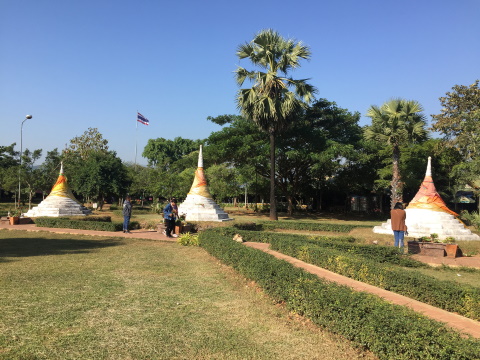| Back to Back Issues Page |
 |
|
Bangkok Travelbug March 2020 The Three Pagoda Pass, Kanchanaburi March 16, 2020 |
| Hello
Background Information The Tenasserim Range (Tenasserim Hills) is a mountain chain that stretches from Mae Sot in Tak province to Kanchanaburi province forming a physical barrier separating Western Thailand and Myanmar. The range continues south down the Isthmus of Kra, the narrow strip of land connecting Thailand and Malaysia and down the spine of the Malay Peninsula. The approximate length of the Tenasserim Range is 1,700 km. Along the Thai-Myanmar border there are only two places where crossings can be made through the Tenasserim Range. The first is at Mae Sot in Tak province and the second the Three Pagoda Pass in Sangkhla Buri, Kanchanaburi province. 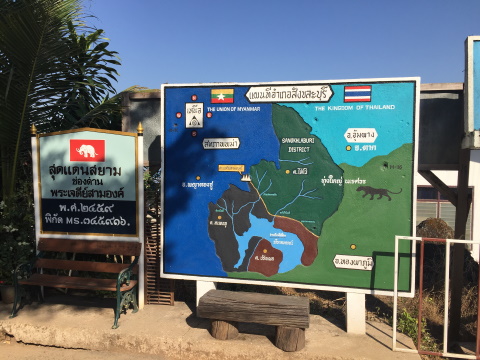
The Thai-Myanmar border at the Three Pagoda Pass Please see terrain map of the Tenasserim Range to have an idea of the area. If the map doesn’t appear, click on this link From the plains of south-eastern Myanmar there is a strip of land that funnels through the Tenasserim Range with the funnel mouth at the Three Pagoda Pass. 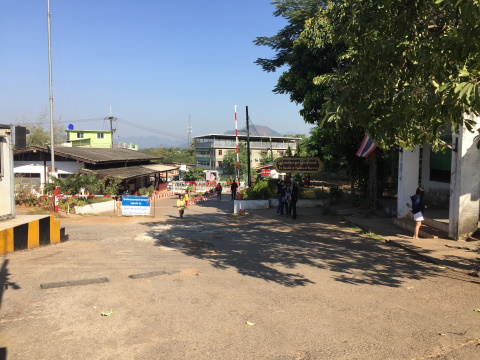
Border crossing at the Three Pagoda Pass from Thailand looking towards Myanmar Once through this pass the funnel continues through the narrow Khwae Noi Valley until it opens up to Kanchanaburi City and the Central Plains of Thailand. This physical feature provides a natural corridor of movement linking India and Myanmar in the west to Thailand and the Indochinese region in the east. This characteristic is to have profound historical impact in the area for centuries to come. Contents The Passage of History Let us examine some of the major historical events that occurred in the Three Pagoda Pass and the area around it. The Introduction of Buddhism in Thailand Based on archaeological excavations at Nakhon Pathom, historians believe that Buddhism in Thailand was introduced in the 3rd C BC during the reign of the Indian Emperor Asoka. The emperor who was Buddhist sent missionaries to spread the Theravada or Hinayana form of Buddhism as practised in Thailand today. Later on, in the 6th C BC* people of Mon stock from Burma emigrated to Thailand and established a Buddhist civilisation called Dvaravati in Central and North-east Thailand. The Dvaravati influence was located at several centres like Nakhon Pathom, Suphanburi, Lopburi and Korat. These missionaries and immigrants mostly came overland and must have travelled through the Three Pagoda Pass and the Khwae Noi valley which provided the mostly convenient access to Central Thailand. The Three Pagoda Pass also provided a vital link in the overland trade route between old Burma and Siam**, as these countries were called then, linking the Gulf of Martaban to the Gulf of Thailand. Note *Some historians believe this event took place earlier in the 3rd C BC with the first introduction of Buddhism to Thailand. **The country we now know as Thailand was originally called Siam until 1939, when the then Premier Field Marshal Phibun Songkhram changed the name to Thailand (the Land of the Free). In 1989, the military junta changed the country’s name from Burma to Myanmar. When referring to events in the past, we will as far as possible, use the old names. The Angkor Empire In the early 10th C King Jayavarman II established his capital in Angkor in present Cambodia. This empire spread its power and influence over large parts of Northeast and Central Siam. Later in the 12th – 13th C in the reign of King Jayavarman VII, a vast network of road, bridges and religious sanctuaries were built linking Angkor to the rest of Siam. These religious sanctuaries or prasart (abode of the gods) were meant to be places of rest, meditation and prayers for pilgrims travelling through the region. Most of these sanctuaries were located in North-eastern Siam. However, there was one Prasart Muang Sing located in the Khwae Noi valley at the western extremity of the empire. The location of this sanctuary most probably catered to the pilgrims travelling between Siam and India through the Three Pagoda Pass. 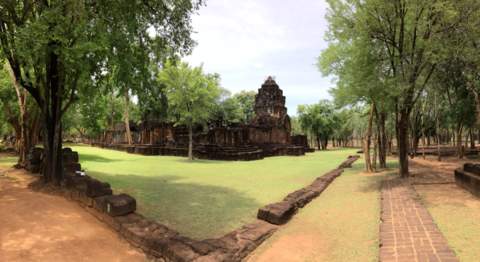
Prasart Muang Sing Siamese Burmese Wars 1569 - 1767 From the 16th C onwards, only wars and invasions passed through the Three Pagoda Pass. In 1569, the Burmese captured Ayutthaya and installed a weak vassal king. It was only in June 1590, when King Naresuan became king, was Ayutthaya able to thrown off Burmese dominance. Towards the end of 1592, the Burmese Crown Prince led an army through the Three Pagoda Pass to Kanchanaburi and into Suphanburi. King Naresuan and his forces confronted the Burmese at Nong Sarai and soundly defeated them, thus securing the independence of Ayutthaya. 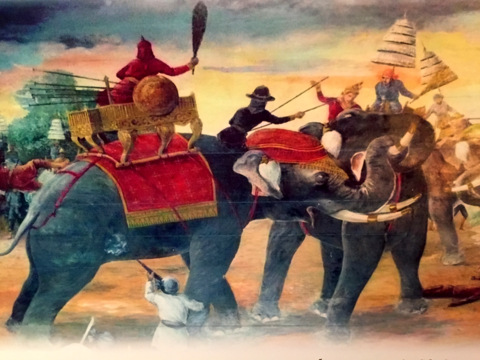
The Battle of Nang Sarai 1593 – courtesy of Suphanburi National Museum In 1763, the Burmese launched their offensive with the major effort in the north to capture Chiang Mai and advanced south to Ayutthaya. A second force came from the south through Chumphon and Petchaburi. A minor effort crossed the Three Pagoda Pass to capture Ratchaburi and Suphanburi. In 1767, the combined Burmese forces captured Ayutthaya and completely destroyed the city. 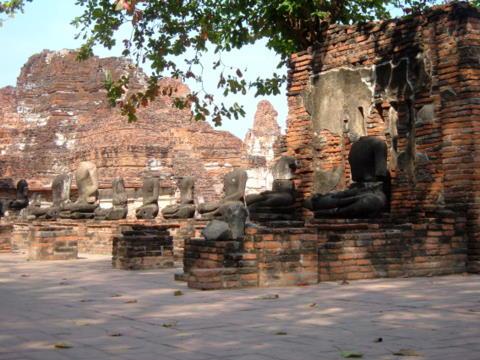
Beheaded Buddha statues in the ruins of Wat Mahathat, Ayutthaya Burmese Invasion 1785 In 1785, in the reign of King Rama I, the Burmese launched a massive invasion of Siam. This became known as the Nine Army Battle because of the five armies deployed by the Burmese and four armies by the Siamese. This time the Three Pagoda Pass was at the main focus of the war. The main Burmese force under the command of King Bodawhpaya crossed the Three Pagoda Pass and advanced on Kanchanaburi. 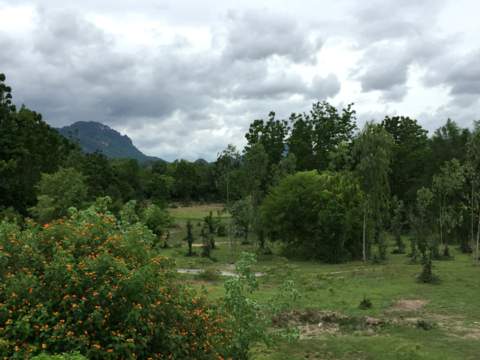
The Khwae Yai valley viewed from the Nine Army Battle Historical Park They were met by the main Siamese force commanded by the younger brother of Rama I deployed in Kanchanaburi to block the Burmese advance. The two forces clashed and the Burmese force was defeated. Another Burmese force coming from the south was also defeated in Ratchaburi. 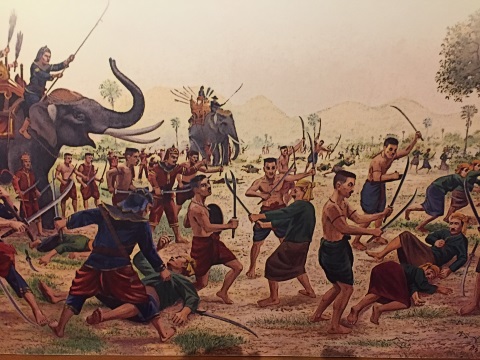
Battle to block the Burmese advance in Ratchaburi 1785 – courtesy of the Ratchaburi National Museum In late 1785, the Burmese launched another invasion in a single effort through the Three Pagoda Pass. Again, they were defeated and ceased to be a threat from then on. World War II and the Death Railway The Three Pagoda Pass continued to be a silent witness to war and suffering right into the 20th C. At dawn on 8 December 1941, the Japanese landed two armies in Southern Thailand. The 25th Army advanced south to invade Malaya and the 15th Army advanced north to invade Burma with the ultimate intention of invading India. This army went through the Three Pagoda Pass. With the 15th Army in Burma, the Japanese had an ambitious plan in 1942 to build a railway linking Bangkok to Kanchanaburi through the Three Pagoda Pass and into Burma. This rail link was to provide the logistic support for their troops in Burma. 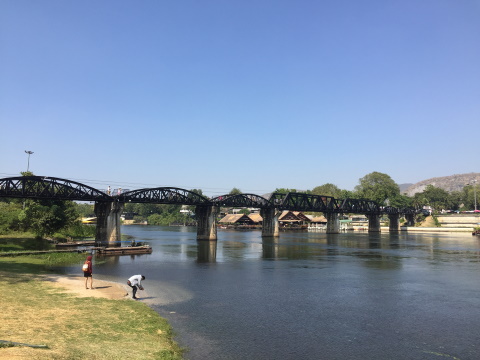
Bridge over the River Khwae, Kanchanaburi Back then the railway from Bangkok stopped at Nong Pladuk Junction in Ban Pong, Ratchaburi. The Japanese planned to build a 415 km-railway linking Bang Pong to Thanbyuzayat. From here on an existing railway line will link to Rangoon (present day Yangon). 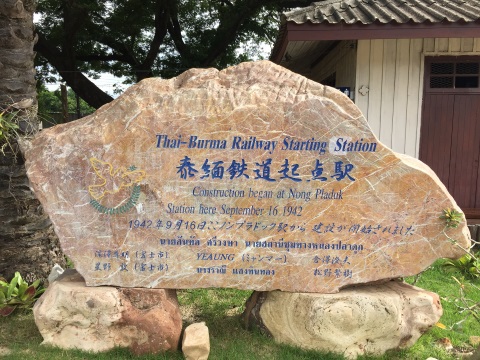
Stone marker showing the start point and date of the Death Railway The project started on 16 September 1942. Sixty-eight thousand Allied prisoners of war (POWs) were transported from Singapore to Ban Pong to work on the railway, 12,436 died. Two hundred thousand Asian labourers were forced to work on the line, more than 80,000 died. The tens of thousands of deaths from sickness, malnutrition and ill-treatment earned the railway the name, “Death Railway”. 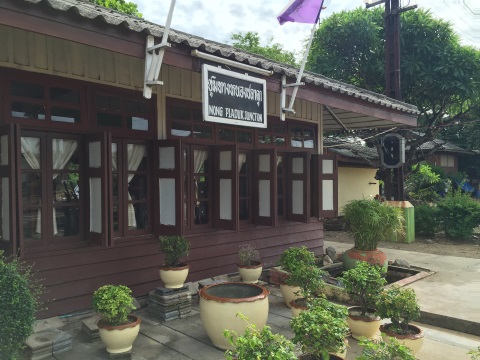
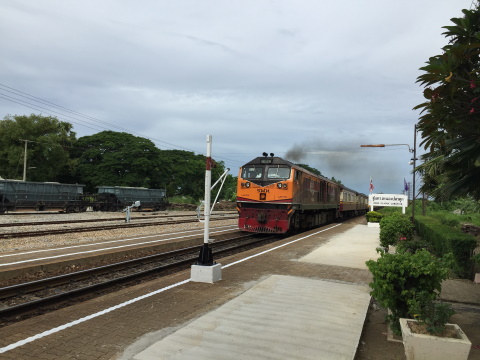
The Nong Pladuk Junction – here travellers can continue west to Kanchanaburi or south to Southern Thailand Contents The Three Pagoda Pass today Peace has prevailed in the Three Pagoda Pass over the past 70 years since 1945. There has been the occasional flow of refugees into Thailand every time there is fighting between the Myanmar Army and the Mon State Army. Other than these isolated incidents, it has been relatively peaceful. There is a bustling market just before the border crossing. This market is located at the western extremity of Thailand and the market is wedged into a rectangular strip of land that protrudes into Myanmar. 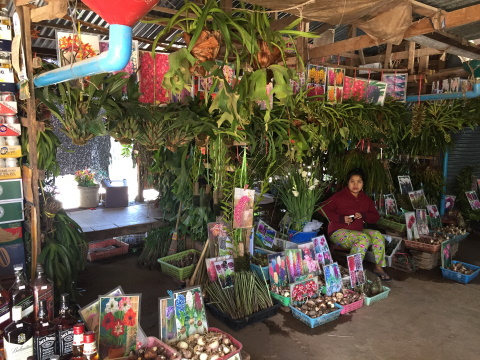
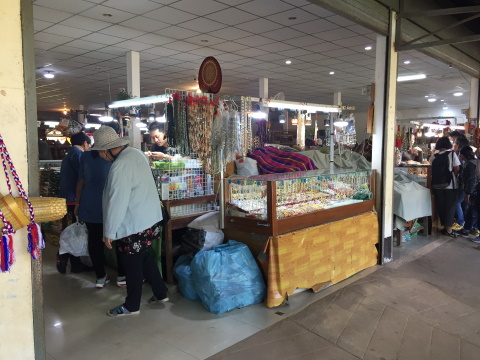
Shops in the market 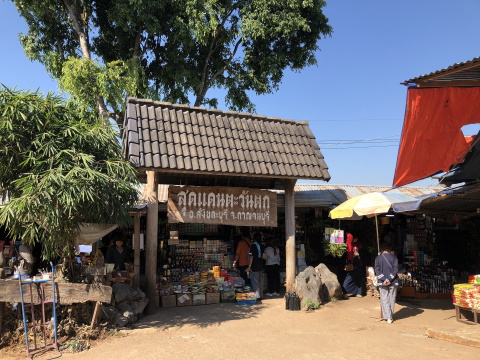
Sign indicating the western extremity of the Thai border, Myanmar is just behind this shop This stall isn’t in the main market but along the road leading from the carpark. 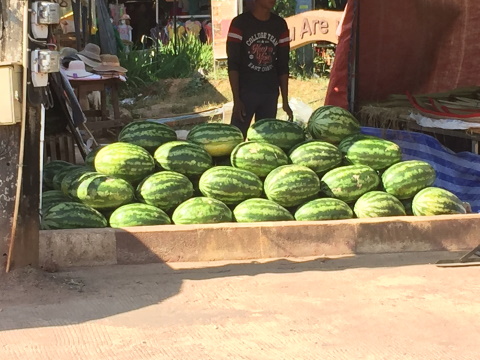
Have you ever seen such huge melons? As we were strolling past the shops near the border, we came across these inscriptions set in a huge stone slab indicating the map of the Death Railway and the casualties during the construction of the line. This stone memorial was installed in 1995 to commemorate the 50th anniversary of the end of the World War II. 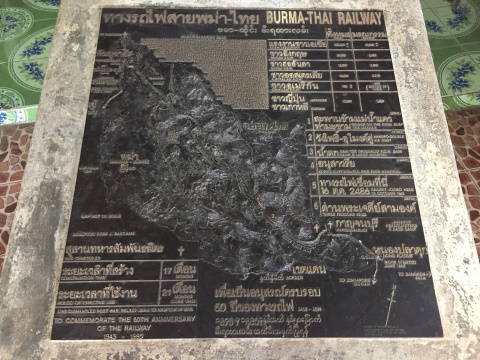
Map indicating the various points along the railway 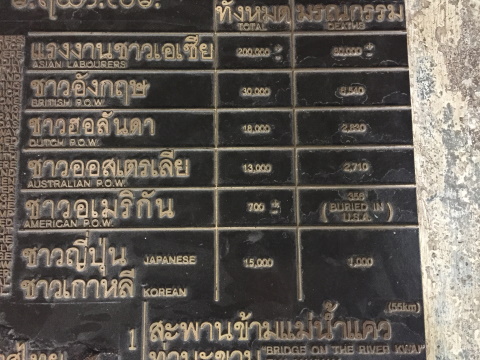
Breakdown of Asian labourers and Allied POWs involved in construction and the number of deaths The block of stone in which these inscriptions are set contains a time capsule containing gifts from surviving ex-POWs to the people of Thailand. It’s to be opened on 25 April 2045. 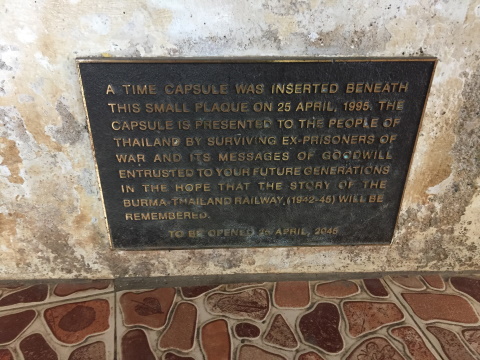
Time capsule In 1959, the Thai government dismantled the Death Railway and it was re-laid to go as far as the Nam Tok Station in Sai Yok. For visitors coming from Bangkok this is as far as you can go by train. Short stretches of railway have preserved in the area of the Three Pagoda Pass for historical purposes. 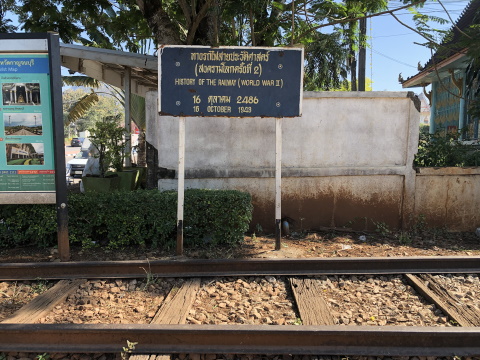
Old railway preserved near the pass 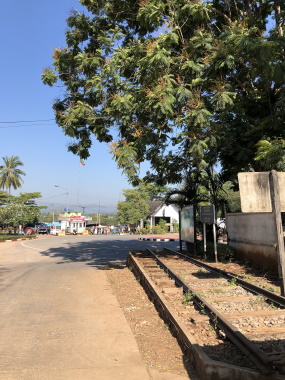
The border is in the distance As we walked back to the carpark, we came across this shrine, the Thailand-Japan Shrine of Peace. 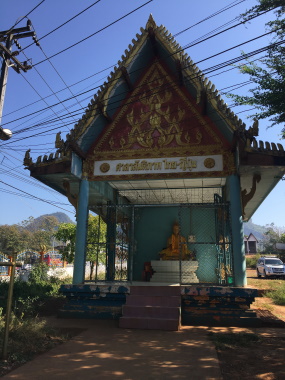
May there be peace on Earth 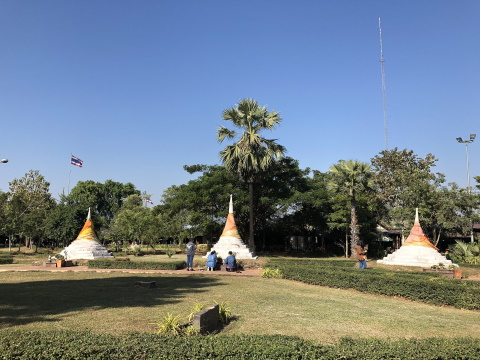
Silent witnesses to so many wars and so much human suffering Contents References and related links References Thailand – A Short History by David K. Wyatt, Second Edition 2003 Buddhism in Thailand by Karuna Kusalasaya, Buddhist Publication Society, Sri Lanka, First Edition 1965, Second Reprint 1983 Related links to previous issues Ayutthaya – from the ashes of destruction Muang Sing Historical Park Kanchanaburi Ancient City Contents Map to the Three Pagoda Pass If the map doesn’t appear, click on this link How to get to Sangkhla Buri It takes a four-hour drive to get from Bangkok to Sangkhla Buri. To make it worth the effort, stay a couple of days at Sangkhla Buri and visit the other attractions as well. For details on how to get to Sangkhla Buri town and where to stay, please refer to the details in the map section of the Bangkok Travelbug January 2020. How to get to the Three Pagoda Pass from Sangkhla Buri From Sangkhla Buri, turn right at the main road and continue on to the junction with route 323. Turn left into route 323 and continue on to the Three Pagoda Pass. Have a safe and enjoyable trip! See you next month. Next month we will take a boat ride to an island off Chonburi. Happy Songkran! Contents Next month Koh Si Chang, Chonburi If you enjoyed reading this e-zine, please forward it to a friend. If you received this from a friend and found it interesting, please subscribe at Bangkok Travelbug. What do you think of the Bangkok Travelbug? We love to hear from you What other subscribers have said Till next month then. Eric Lim Tour Bangkok Legacies Find us on Facebook My Journey through Thailand Part I The First Steps This is my second e-book and the first in the series of travel journals on my trips to explore the various provinces in Thailand. This edition, which covers my travels from late 2009 to mid-2013, will guide you to historical sites, cultural monuments and exquisite Thai handicraft, across a vast spectrum of cultural and ethnic diversity. You can have a virtual tour with this e-guide book or take the first steps yourself in this journey through Thailand. My Kindle e-book 
Copyright@2008-2020 Tour Bangkok Legacies All rights reserved
|
| Back to Back Issues Page |
